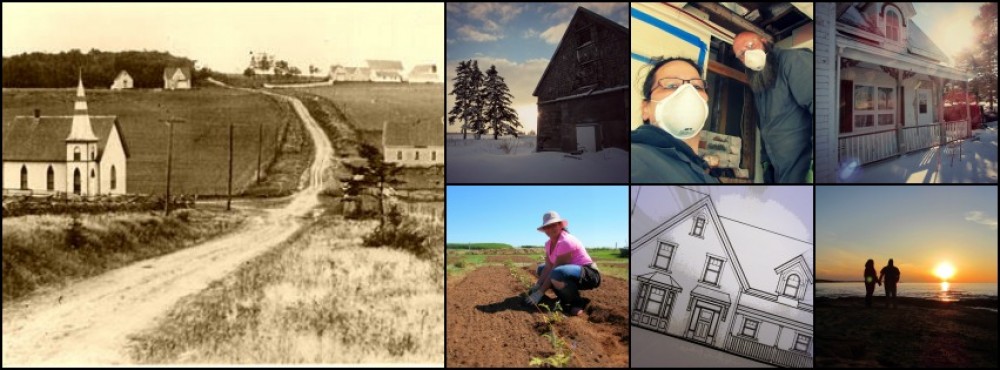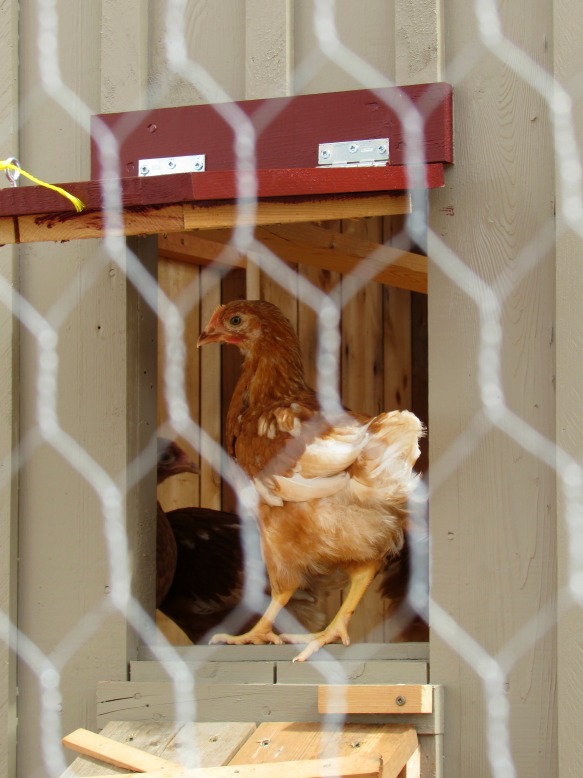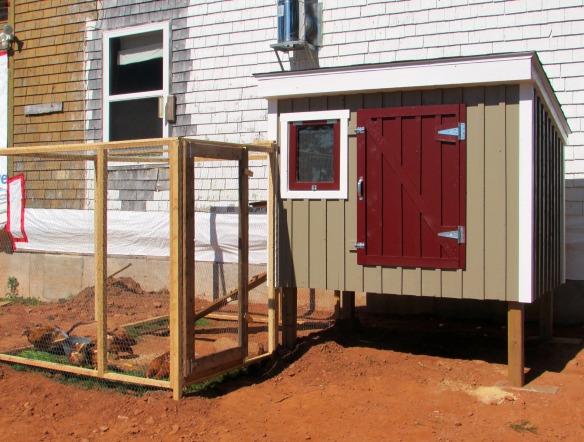News flash: Chickens grow fast.
With that realization, we stepped up our game last week and built the coop for our six “Golden Girls”. We’ve been holding out on building it in hopes we would be able to have our new garden shed built at the same time. The plan was to have the coop attached to and shared with the shed – making the care for the chickens and egg collecting easy and efficient.
Unfortunately with fall approaching, we find ourselves short on funds to build the luxury shed. While we will be using the majority of the salvaged material for the shed, it will still cost more than we have to get it the way we want it – so for now, a quick and easy coop is the way to go. And because it’s “temporary”, inexpensive as well.
Before we go further, we’ll take a little walk back in time. Remember the original addition attached to the back of our house that we removed in the spring?
We carefully dismantled everything and stored the material in the barn and yard for future use.
That’s where we began.
A quick look through the pile and I found a couple of pressure treated 4″x4″ posts and some 2″x8″ joists taken from the back porch and deck. I had a sheet of plywood left over from building our garbage chute that we used when we were gutting the second floor of the house – we’ll use that for the floor. The concrete blocks were left behind from a previous owner and taken out of the old crawlspace prior to our foundation getting done.
So far no cost to us.
Once the deck and floor was built, we scavenged some 2″x4″s and framed the walls and roof. Rather then sheathing the coop with plywood and applying some sort of siding, we elected to use the pine boards taken from the old addition ceiling and made board and batten siding applied directly to the frame – no plywood.
We debated the exterior finish for the coop. Would we leave it natural? stain the wood? paint? Given our location and climate, leaving it unfinished wouldn’t be an option. It wouldn’t take long for the exposed pine and spruce to deteriorate and although it’s a temporary home for the girls, I want it to last. We’ve been trying to decide what colors to paint our house next year and thought we’d test our choices on the coop. But then again, paint’s not cheap either. That’s when I remembered that somewhere in the house is a box with some of the paint we brought with us from Ontario. The taupe was from our garage door and trim, the red from our front door.
The window was one of several we found in the barn from who-knows-where, but it was perfect for our needs. I just had to build the frame for it. We also built the door for the coop with the pine boards. From there, we finished the framing and and sheathed the roof with a sheet of OSB sheathing we used inside for the baffle vents in our attic. When we cleaned out the barn shortly after moving to PEI, we found part of a bundle of shingles the previous owner used for some roof repairs.
We bought three lengths of shingle/fascia flashing, a quart of white paint and the door and window hardware.
With the coop done, we built the run with a few more pieces of salvaged lumber and the chicken wire we bought at the local farm co-op. The mesh extends below the bottom of the run and laid into a trench just outside the frame. It was buried with whatever stone we could find handy and then backfilled with soil. The idea is to keep anything outside the coop that wants in, out. (That sentence makes sense, right?)
Vanessa then dug up a few patches of grass and replanted it into the run. They’ll eat some of the grass and want to dig and scratch as well.
And there you go. The only thing left was to introduce the girls into their new home.
Then we realized they didn’t have a ramp to get from the coop into the run and back.
So with the last of the scraps I had around, we quickly assembled the ramp and left the birds to explore.
So far, they seem to love the new environment. The chicks may have been cute but to be honest, I’m happy to get them out of our house and frankly, I think they’re just as happy to get out of their cramped brooder.
So I think we met our objective: for just over a hundred bucks we’ve built a great reclaimed-wood chicken coop. Even the two enamel pots we use to bring the kitchen scraps to the girls were found underneath the old rear-yard deck we demolished.
The one thing we’ll have to do before winter sets in is to insulate the coop. I framed it to allow for a quick installation of 1-1/2″ styrofoam insulation to the walls, ceiling and floor which we’ll do when we can afford it. But we’ve learned that chickens are tough birds and will handle our cold winters with relative ease.
Next year, when we build Chicken Coop 2.0, we’ll likely move this one to the back and use it for the meat chickens we plan on having – or perhaps a small coop we use when introducing new birds to our flock. Either way, it turned out better than we hoped for and we’ll find a good use for it!
Now we just wait for eggs.























